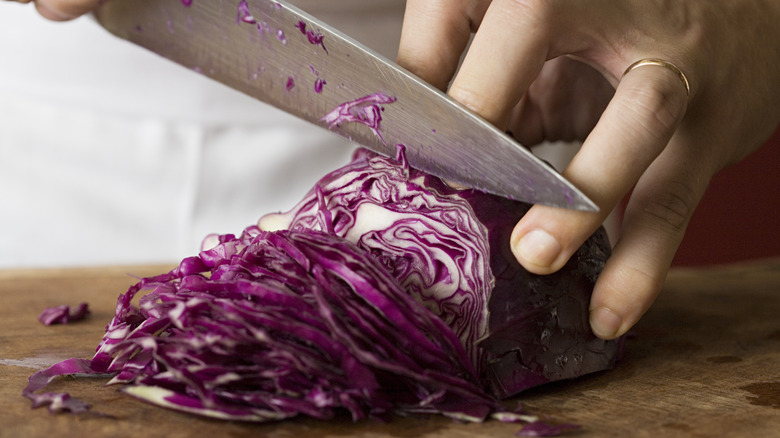Cabbage Water Is Your Secret Weapon For Vibrant Color-Changing Food
Kyra Condie may be best known for being one of Minnesota's (and America's) best rock climbers despite having a surgically fused spine, but she's something of a food scientist, too. In a recent TikTok, she demonstrated an example of the magic of pH indicators: By adding lemon juice to red cabbage water, she turned a purple liquid pink.
What she didn't show was that adding baking soda or soap would cause the pink to turn purple-ish blue again; a little more would deepen the color to a darker blue and then green. Is Condie secretly magical? Well, maybe — anyone who has seen her rock climb could easily suggest that. But that's not what's happening in her video.
Is it a trick of the light? Actually, kind of! All color is, technically, a trick of the light. And if you understand the science behind it, you can use it to create some magical, color-changing food at home.
The science behind how cabbage water changes color
Red cabbage gets its hue from a natural, water soluble chemical called anthocyanin. Beyond having various health benefits, it's also a chemistry lesson. The color change happens because the anthocyanin molecule actually changes structure at different pH levels. In acidic, low pH environment, they are protonated: the hydroxide (OH) groups — covalently bonded hydrogen and oxygen atoms — still have their hydrogen, the ion is positive, and the molecule absorbs blue green light, so you see red light waves and the liquid turns pink.
@kyra_condie Lil at home science experiment 🤯
As the solution becomes more neutral, protons are lost from the phenol groups and the molecules start absorbing light from the yellow-orange spectrum, and you start seeing purple turn to blue, then teal, then to green as the solution becomes basic.
All of that is a lot of chemistry to say that adding an acid like lemon juice, as Kyra Condie does on TikTok, will make cabbage water turn pink, and adding an alkaline substance like baking soda will deprotonate the molecules, turning them blue.
Harnessing the magic of pH indicators in food and drink
Knowing that pH affects the color of your cabbage will help you adjust the visual impact of your recipes. If you want to retain a bright purple color in your cooked cabbage, hit it with a splash of vinegar or citrus juice right before serving. If you're looking for a deeper purple or blue hue, blanch your cabbage in a baking soda bath.
Many naturally purple or blue foods and flowers are pigmented with anthocyanins: butterfly pea flowers and blueberries, for example. Empress Gin gets its iconic purple from butterfly pea flowers, and a bottle easily allows you to create color-changing cocktails. Pea flower tea can be turned into shaved ice for a color-changing grapefruit basil kombucha mocktail. Meanwhile, Suncore Foods uses the tea to make a beautiful blue pudding and homemade blue boba pearls. Both could be swapped for cabbage water or blueberry juice.
Christine Liu shows how to soak rice vermicelli in cabbage water to quickly take on the bluish purple tint and then turn them pink in an acidic sauce for ombre noodles. As the noodles rehydrate, they absorb the anthocyanins in the water and take on the color. This concept could be easily applied to spring roll wrappers, giving you and your dinner guests a magic show as the rolls are dipped into a sesame ponzu vinaigrette. If you can make it with anthocyanin-rich ingredients, your dinner wil be that much more magical.


